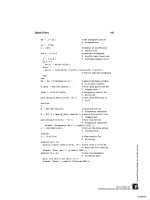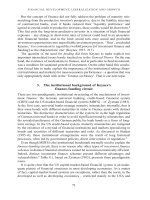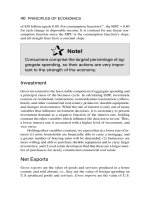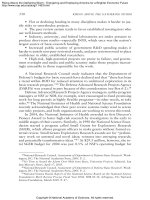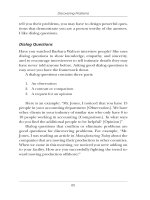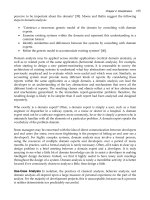Candlestick and pivot point trading triggers setups for stock forex and futures markets 2007 phần 4 pot
Bạn đang xem bản rút gọn của tài liệu. Xem và tải ngay bản đầy đủ của tài liệu tại đây (2.36 MB, 37 trang )
higher closing high. We have not yet discussed candle patterns; but for
those already familiar with that charting method, you will notice that it is a
higher close above the doji high. The trigger to go long is on the close or the
next open, once the market makes a higher closing high, which in Figure 3.1
would be at 10810.
When the market trades near the daily projected resistance, as deter-
mined by using pivot point analysis, once prices start to make lower clos-
ing lows, which is a clue that helps us identify that the uptrend has
concluded. That is what generates a sell signal at 10838. That would be a
profitable scalp of 28 points at $5 per point, which is $140 on a day trading
margin of $500, which is what most futures brokerage firms charge.
STOCHASTICS CONFIRMS THE TURN
Now looking at the sell signal, we would have an opportunity to go short at
10838 as the market pivots and turns, as I say, off the resistance level as the
stochastics confirms with a %K and %D hook sell signal once both lines
cross and close below the 80 percent line. Follow the flow of the market
after that point: lower highs, lower lows, and, more important, lower clos-
ing lows all the way down to a low of 10739. That is a 99-point decline or
$495 per contract—almost a 100 percent return on your day trading margin.
As the market declines, we see the stochastics crossing above and back
below its respective values; but never does it cross back and close above
the 20 percent line. I am asked at what level do you take profits. I will go
over specific target exit levels later; but for right now, the most simplistic
answer is at the last trading price near 10758. The reason is that this would
have been a day trade; and as you can see from the bottom of the chart, the
day is running short on time. Profit objectives can be based not only on
price targets but also on time limits.
Figure 3.2 shows a pattern similar to that in Figure 3.1: a higher close
above a doji high. Candle chart aficionados may see a variation of a morn-
ing doji star pattern. I keep it very simple; I call it an HCD pattern, which
stands for a high close doji. This pattern has specific rules on entry and
exits and will be disclosed in just a bit. For now, please focus your attention
on the fast stochastics, as %K and %D both confirm the trigger to go long
once both lines cross and close above the 20 percent line. That trigger cor-
responds on the close of the candle, which was 10756. As the market moves
higher, follow the flow again as the momentum builds. The stochastics does
not generate a sell signal, as the high was made at 10805. We see a
crossover of %K and %D above the 80 percent line, but the stochastics does
not close back under that line.
The 20 percent and 80 percent levels in relationship with the %K and
How to Read Oscillators to Spot Overbought or Oversold Conditions 97
c03.qxd 9/25/06 8:22 AM Page 97
%D values will help confirm your entries and exits in the markets, espe-
cially when you follow the trend or market flow as shown by the candle
charts. There is a reason why I have focused on the high close doji signal,
as we shall soon discover from a back-test study on percentile perspective.
But once again, this chapter is to help you better understand the confirm-
ing power that stochastics offers.
Markets need volatility in order to move, and we need markets to move
in order to trade. We also need to base our trading plans on reliable signals.
Not all times do the setups that trigger an entry work as perfectly as in
these examples, which is why I have other confirming signals to corrobo-
rate timing a trade signal. I also like to see if the methodology works in a di-
verse group, or noncorrelated markets. Testing for robustness, or how well
a system or signal responds in different markets, helps validate the relia-
bility of that signal. The chart in Figure 3.3 is a spot forex euro currency
that demonstrates the same setup and trigger that would enter a long posi-
tion with %K and %D crossing over above the 20 percent line with a con-
98
CANDLESTICK AND PIVOT POINT TRADING TRIGGERS
FIGURE 3.2
RealTick graphics used with permission of Townsend Analytics, LTD.
c03.qxd 9/25/06 8:22 AM Page 98
firming higher closing high candle pattern. The sell signal also works well
as confirmed when %K and %D both cross over and close back below the 80
percent line.
TIPS AND TRICKS TO HELP
There are other tips and tricks associated when using stochastics. There
are fast stochastics and slow stochastics. The difference is in how the pa-
rameters are set to measure the change in price. This is referred to as a
gauge in sensitivity. A higher rate of sensitivity will require the number of
periods in the calculation to be decreased. This is what “fast” stochastics
does. It enables one to generate a faster and a higher frequency of trading
signals in a short time period. The previous two examples used the default
fast stochastics settings, which help you discover the cycles of tops and
bottoms faster than the slow stochastics setting will.
How to Read Oscillators to Spot Overbought or Oversold Conditions 99
FIGURE 3.3
RealTick graphics used with permission of Townsend Analytics, LTD.
c03.qxd 9/25/06 8:22 AM Page 99
Stochastics Patterns
One other method in which to use the stochastics indicator is trading off a
pattern called bullish convergence. It is used in identifying market bot-
toms—where the market price itself makes a lower low from a previous
low, but the underlying stochastics pattern makes a higher low. This indi-
cates that the low is a “false bottom” and can resort to a turnaround for a
price reversal. Figure 3.4 shows how prices make a secondary low signifi-
cantly lower from a primary low, which is posted by a low in the stochas-
tics indicator.
The reverse of this signal is a trading pattern called bearish divergence.
It is used in identifying market tops—where the market price itself makes
a higher high from a previous high, but the underlying stochastic pattern
makes a lower high. This indicates that the second high is a “weak” high
and can resort to a turnaround for a lower price reversal. Figure 3.5 shows
100 CANDLESTICK AND PIVOT POINT TRADING TRIGGERS
FIGURE 3.4
RealTick graphics used with permission of Townsend Analytics, LTD.
c03.qxd 9/25/06 8:22 AM Page 100
how the market makes a secondary high, but the corresponding high in the
stochastics is at a lower level than the price charts’ primary high point.
This stochastic pattern can alert you to a false breakout. Notice the low
close doji (LCD) off the secondary peak; and then as %K and %D both cross
over and close back beneath the 80 percent line, a sell trigger is generated.
That signal warns of an impending, prolonged downtrend of substantial
proportion. Therefore, it is important to monitor for divergence patterns.
Rules to Trade By
The bearish divergence pattern signals that there is an impending price re-
versal ready to occur in a market. As I mentioned previously, you can an-
ticipate and get ready to place an order to act on the signal; but you should
not act until the confirmation of a lower closing low triggers the entry,
which would be to act on the close or the next open. Here are four rules to
guide you to trading a stochastics divergence pattern:
How to Read Oscillators to Spot Overbought or Oversold Conditions 101
FIGURE 3.5
RealTick graphics used with permission of Townsend Analytics, LTD.
c03.qxd 9/25/06 8:22 AM Page 101
1. The first peak in prices should correspond with a peak in the %K and
%D reading above the 80 percent level.
2. The second peak must correspond to a significant higher secondary
price high point.
3. If the secondary stochastics peak is less than or under the 80 percent
level, this signals a stronger sell signal.
4. Prices should make a lower closing lower to confirm a trigger to enter
a short position. Enter on the close of the first lower closing low or the
next open. The protective stop should initially be placed above the high
of the secondary high.
Figure 3.6 demonstrates a bearish divergence setup with the rules de-
scribed. This is a 15-minute candle chart on the CBOT mini-Dow. The sec-
ondary high is established at 10940. Both %K and %D make a primary high
above the 80 percent line, and the secondary high in price corresponds with
%K and %D below the 80 percent level. Once the long dark candle closes
below the prior low (in fact, it closes below five prior candles lows), a sell
signal is triggered. The initial entry is made on that time period close or on
102
CANDLESTICK AND PIVOT POINT TRADING TRIGGERS
FIGURE 3.6
RealTick graphics used with permission of Townsend Analytics, LTD.
c03.qxd 9/25/06 8:22 AM Page 102
the next open, which in this case is 10897. The stop is placed at 10945,
above the high of the secondary peak high. As you can see, the market con-
tinues to decline into the close down to 10836, for a 61-point gain had you
exited on the close. That equates to a gain of $305 on a day trade margin of
$500 per contract. Notice that as the market declines, the stochastics indi-
cator remains below the 20 percent line as the %K and %D cross multiple
times but never back above the 20 percent level to trigger a buy signal until
after the electronic day session close, which is 4
P
.
M
. (CT).
MACD
In simplest terms, moving average convergence/divergence is an indicator
that shows when a short-term moving average crosses over a longer-term
moving average. Gerald Appel developed this indicator as we know it
today, and he developed it for the purpose of stock trading. It is now widely
used for short-term trading signals in stocks, futures, and forex markets, as
well as for swing and position traders. It is composed of using three expo-
nential moving averages. The initial inputs for the calculations were a 9-pe-
riod, a 12-period, and a 26-period. The concept behind this indicator is to
calculate a value, which is the difference between the two exponential mov-
ing averages, which then compares that to the 9-period exponential moving
average. What we get is a moving average crossover feature and a zero-line
oscillator, and that helps us to identify overbought and oversold market
conditions.
I might add that because traders are now more computer savvy than
ever before and because many charting software packages such as
RealTick allow traders to change or optimize the settings or parameters, it
is easy to change, or “tweak,” the variables in Appel’s original calculations.
Traders can increase the time periods in the moving average calculations to
generate fewer trade signals and can shorten the time periods to generate
more trade signals. Just as is the case for most indicators, the higher the
time periods used, the less sensitive the indicator will be to changes in
price movements. MACD signals react quickly to changes in the market—
that is why a lot of analysts, including myself, use it. It helps clear the pic-
ture when moving average crossovers occur. It measures the relative
strength between where current prices are as compared to past time frames
from a short-term perspective to a longer-term perspective.
The MACD indicator is constructed with two lines: One is the 9-period
exponential average (slow line), and the other is the difference between the
12- and 26-period exponential moving averages (fast line). In general, when
the fast line crosses above the slow line, a buy signal is generated; the op-
posite is true for sell signals.
How to Read Oscillators to Spot Overbought or Oversold Conditions 103
c03.qxd 9/25/06 8:22 AM Page 103
The MACD also has a zero baseline component, called the histogram,
that is created by subtracting the slower signal line from the MACD line. If
the MACD line is above the zero line, prices are usually trending higher. The
opposite is true if the MACD is declining below the zero line. The MACD is
a lagging indicator; that is, it is based off moving averages. We want to look
for the zero-line crossovers to identify market changes and to help confirm
trade entries or trigger action to exit a position. As you can see in the e-
mini–Standard & Poor’s (S&P) chart in Figure 3.7, the MACD readings cross
back above the zero line, indicating a confirmed shift in momentum. That
zero-line cross helped filter out the bottoming process. A long position
would have been initiated at the close of the candle or at the next time pe-
riod’s open at 1267.25, which resulted in an immediate price gain, carrying
prices up over 1270.
Clues that identify shifts in momentum as the market moves from one
extreme to another or from overbought to oversold to trigger a trading op-
portunity can be identified with the aid of MACD readings in both the mov-
ing average and the histogram component. While profits are higher when
104
CANDLESTICK AND PIVOT POINT TRADING TRIGGERS
FIGURE 3.7
RealTick graphics used with permission of Townsend Analytics, LTD.
c03.qxd 9/25/06 8:22 AM Page 104
buying the absolute bottom, that is a haphazard guessing game to play.
Trading based on a set of rules and using a confirming indicator to identify
a change in price direction and then following that price movement are the
keys to making money in the markets. Figure 3.8 shows an e-mini–S&P ex-
ample; the intraday trend is established to be higher by 10
A
.
M
., as the sym-
metry of higher highs and higher lows exists. The MACD confirms an HCD
trigger as the histogram bar crosses above the zero line, initiating a long at
1234.75. Notice that the histogram bars continue to expand higher, con-
firming that the bullish momentum is accelerating. Identifying a zero-line
cross is a powerful tool in confirming entries, and watching the progression
of the histogram bars may help you maintain a winning position.
It is not in every single instance that we see the MACD signals work ex-
actly the same as Figure 3.9 demonstrates. The histogram was not under
the zero line; therefore, a zero-line cross did not trigger. However, observ-
ing that the histogram bars move higher as prices start to advance would
certainly help confirm the strength of the uptrend.
How to Read Oscillators to Spot Overbought or Oversold Conditions 105
FIGURE 3.8
RealTick graphics used with permission of Townsend Analytics, LTD.
c03.qxd 9/25/06 8:22 AM Page 105
RELY ON THE PATTERNS
Another method useful with the MACD indicator, and one that is more reli-
able for determining a trend reversal, is to identify the pattern called bull-
ish convergence. This is where the market price itself makes a lower low
from a previous low, but the underlying MACD pattern makes a higher low,
as shown in Figure 3.10. This indicates that the second low is a weak, or
“false,” bottom and can resort in a turnaround for a sharp price reversal.
This is similar to stochastics; however, since it is developed from moving
averages, the timing of the shorter-term versus the longer-term moving av-
erages can delay such a signal. There is a high probability that MACD and
stochastics work more so than other indicators with this pattern.
As you can see in Figure 3.10, which is a five-minute chart on Intel, the
market made a lower low in the next trading session where the MACD his-
togram makes a higher low. Notice the HCD signal. Then as the price starts
to appreciate, the MACD histogram triggers or confirms a long position
with a zero-line crossover, and the progressively higher histogram bars con-
106 CANDLESTICK AND PIVOT POINT TRADING TRIGGERS
FIGURE 3.9
RealTick graphics used with permission of Townsend Analytics, LTD.
c03.qxd 9/25/06 8:22 AM Page 106
firm the positive momentum right into the close of the day. The MACD is a
very useful tool as a confirming indicator once you have entered in a posi-
tion, especially by following the histogram readings.
The MACD has the same principles as far as a sell signal with what is
known as bearish divergence. This is where the market price itself makes a
higher high from a previous high, but the underlying MACD crossover lines
make a lower high. This indicates that the second high is a “weak” high and
can resort to a turnaround for a lower price reversal. In Figure 3.11, a daily
chart in the FX spot euro currency, the MACD histogram helps identify
both bearish and bullish divergence patterns.
One other useful method in using MACD is to follow as stated the di-
rection of the histogram bars to help confirm a turn or a change in trend.
Figure 3.12 shows the price advance in the e-mini–S&P as the market closes
in on a pivot point resistance level, and the market moves from a bullish
condition as prices move higher or in an overbought state and the his-
togram readings start to expand over 300. As the market price conditions
change, as the close is below the open, and as the market makes the first
lower closing low, especially near the pivot resistance line, the histogram
How to Read Oscillators to Spot Overbought or Oversold Conditions 107
FIGURE 3.10
RealTick graphics used with permission of Townsend Analytics, LTD.
c03.qxd 9/25/06 8:22 AM Page 107
108
FIGURE 3.11
RealTick graphics used with permission of Townsend Analytics, LTD.
FIGURE 3.12
RealTick graphics used with permission of Townsend Analytics, LTD.
c03.qxd 9/25/06 8:22 AM Page 108
bars start rolling down or making lower highs as well. In a weak or down-
trending market, the bars should also be making lower highs; and in this
case, they are confirming a sell signal from the change in market condition
as well as the moving average crossover as prices trade under the moving
average lines. This last example is what we will be going over in later chap-
ters as we combine pivot point analysis with candle patterns.
SUMMARY
In conclusion, all oscillators, indicators, and most moving average studies
will give confirmation when a market shifts direction; and knowing these
signals will help you identify a trading opportunity. They also will help give
you a clue when a market is in an extreme price condition, described as
being overbought and oversold. Therefore, as a trader, you need something
that gives you a better idea of entering a trade. The next few chapters will
reveal ways by which you will learn how to identify shifts in momentum be-
fore looking at an indicator as confirmation. Impossible, you say? Well,
there are certain patterns such as the high close doji, the jackhammer can-
dle pattern, a low close doji, or the shooting star formation that, when up
against a projected pivot support or resistance line, will alert you to a trade
entry faster than using these traditional indicators. When I introduce you to
the concept of using a pivot point moving average component as was used
in Figure 3.12, then you will see how it is possible.
How to Read Oscillators to Spot Overbought or Oversold Conditions 109
c03.qxd 9/25/06 8:22 AM Page 109
c03.qxd 9/25/06 8:22 AM Page 110
111
CHAPTER 4
Momentum
Changes
How to Spot Divergence
or Convergence
T
he battle to identify when a trend ends or when a trend will start is
one of the key elements on which traders make their bread and
butter. When a market reaches an unsustainable price extreme either
up or down, we want to be able to be prewarned so we can set up our trad-
ing account with the right contract sizes and preset the buy or sell order
and then wait for the trigger to act. We have the traditional indicators that
we went over in Chapter 3 with stochastics and MACD (moving average
convergence/divergence), but there is one more measure of data we have
that stock traders and longer-term futures traders have been using for over
a hundred years. That one bit of data is called volume. The one disadvan-
tage that foreign exchange (forex) traders have is that there is no way to
measure volume data unless you “borrow” it from the futures markets, as I
shared in Chapter 1.
VOLUME IS THE BEST PRICE CONFIRMATION
TOOL AND TREND INDICATOR
In Chapter 1, we went over the basic rule structure for volume analysis. But
how can we apply that to help confirm market price extremes? This is ac-
tually fairly simple, if you know what to look for. That is what this section
is designed for. It does not matter what market you are trading, whether it
be stocks, futures, or forex. The principles are the same and apply to all
three markets. Remember that a good trader has a reason for entering a
trade. A great trader waits until the signal triggers and then acts on that sig-
c04.qxd 9/25/06 8:23 AM Page 111
nal. Just because a market goes up and is “too high” in value does not mean
it is going down, at least not until the signals are present. Market price ex-
tremes are generally a reflection of high volatility; and with high volatility
comes increased market participation or action, and that action is mea-
sured or reflected by high volume.
OVERBOUGHT MARKET CONDITION—
A DEAD GIVEAWAY
If you drop a boulder off a cliff, it falls at a speed that is much greater than
the speed of the boulder being pushed up a hill. That is the analogy of what
happens when a bull market or uptrend stretches too far too fast, or is
“overbought.” So we look for these types of conditions in which to ride the
price direction if we are looking to establish a short position or we want to
exit a long position before the boulder falls. Using volume analysis in con-
junction with indicators is a powerful tool to help you determine whether a
market price trend may continue. Look at Figure 4.1. This chart on Amazon
112
CANDLESTICK AND PIVOT POINT TRADING TRIGGERS
FIGURE 4.1
Used with permission of www.GenesisFT.com.
c04.qxd 9/25/06 8:23 AM Page 112
is a dead giveaway that the price appreciation was unsustainable; as we
see, the market moved from a bullish trend to a consolidation phase with
higher highs. However the volume levels were declining, giving a direct
clue that the price advance was unsustainable. When combined with the
low close doji pattern, which we will disclose in Chapter 8, and a shooting
star, there was no reason to stay long this market. Notice that as prices
started to depreciate, the volume increased, which reflected sellers’ active
participation, which attracted more selling.
THE “COMEBACK” KID STOCK
In Figure 4.2, we see one of the greatest success stories in 2005 for any com-
pany, Apple Computer. It just could do no wrong, except when the price of
the stock advanced too far too fast, culminating in an overbought unsus-
tainable price extreme. The fundamentals were quite rosy, as holiday sales
were through the roof on iPods and accessories. You want to talk about a
Momentum Changes 113
FIGURE 4.2
Used with permission of www.GenesisFT.com.
c04.qxd 9/25/06 8:23 AM Page 113
racket; this company has products on top of products that accessorize the
accessories, none of which are inexpensive. What a gold mine! Holiday
sales were strong, and the market blasted off. In fact, notice the gap up,
then notice the gap down, leaving what we technicians call an island top.
(This formation is covered in Technical Trading Tactics on page 75.) It
also formed the low close doji pattern. It really is the volume that helped
confirm the market’s overbought condition. As prices broke out of the side-
ways pattern, from a high near 75 as it went onward to over 85, see
the volume decline showing fewer market participants wanting to join the
price advance. As the sell-off materialized, like a boulder falling off a cliff,
more participants started selling as volume increased, signaling a strong
price reversal.
BLOW-OFF TOPS ON VOLUME SPIKES
Volume levels help confirm the true strength of a price move if the market
demonstrates a price increase. If volume does not confirm the market’s
new assigned value, something is wrong and a price reversal is imminent.
Volume is also a great indicator of blow-off tops, or what is called an ex-
haustion rally. Volume spikes or surges can and do indicate price reversals,
especially after a price advance on declining volume is preceded by a lack
of price follow-through. As we study the chart in Figure 4.3, you see that the
huge price advance is accompanied with abnormal or heavier than usual
volume. You would anticipate that a breakout to sharply higher levels
would occur. The high volatility reflects the increased volume levels; and as
the next time frame shows, there is no follow-through to back the price ad-
vance. This is a clear sign of a price reversal. The low close doji trigger also
seals the deal that this was simply a one-day wonder rally that failed, and a
price reversal was to be expected.
114
CANDLESTICK AND PIVOT POINT TRADING TRIGGERS
c04.qxd 9/25/06 8:23 AM Page 114
INTEGRATE VOLUME AND INDICATORS
Volume helps the position trader identify the strength of the trend of the
lack of conviction of market participants. Take a look at Toll Brothers in
Figure 4.4. This stock took a complete nosedive starting in mid-July. Many
thought that the bottom was in and that a rally would take this home
builder back to the highs. Not quite so, said the volume! There was a rally
attempt, but it was on lower volume. Adding the MACD indicator shows
confirmation that a price trend or market rally would not occur. The MACD
signaled a negative zero-line cross, and the moving average components
crossed as well. The low close doji trigger did not help matters for hopeful
bulls either. As the failed rally crumbled, the downtrend resumed and vol-
ume started to increase, confirming a bear trend. The MACD indicator con-
tinued to back that downtrend, warning traders that lower prices would
prevail.
I want to illustrate how you can integrate volume with both MACD and
Momentum Changes 115
FIGURE 4.3
Used with permission of www.GenesisFT.com.
c04.qxd 9/25/06 8:23 AM Page 115
stochastics so you can see how helpful volume analysis can be to indicate
overbought market conditions. Armed with this information, you will have
an easier job identifying trading opportunities and a less stressful time
choosing a strategy. Figure 4.5 shows Toll Brothers at its peak. It was a
media darling. The housing bubble was ready to burst; so when people say
they never saw it coming, they just did not know what to look for. The mar-
ket went into a blow-off phase, which resembles the pattern or condition
that Apple Computer was in in Figure 4.2. The volume was declining on
higher prices, the MACD had a lower high, and stochastics confirmed the
bearish divergence. A low close doji pattern formed at the top (which was
within pennies of the monthly pivot resistance number). Once the price re-
versal occurred, you can see how much volume picked up, confirming the
trend reversal. In fact, the average daily volume levels increased as the
downtrend materialized.
116
CANDLESTICK AND PIVOT POINT TRADING TRIGGERS
FIGURE 4.4
Used with permission of www.GenesisFT.com.
c04.qxd 9/25/06 8:23 AM Page 116
BULLS TAKE CHARGE
I illustrated the relevance of volume confirming technical indicators and
stated the principles that apply to all actively traded markets, including
forex or spot currency traders. The opposite signals work for identifying
bottoms in all actively traded markets. Let’s look at one of my favorite
stocks, Starbucks. What an experience! Paying two bucks for a cup of black
joe! I’ll tell you what, if it hadn’t been for my friend Les Zieba (my coffee
connection) and Starbucks, this book would most likely never have been
finished. Just on my intake of Ventes alone writing this book, I probably
added a dollar per share to the value of this stock. In any event, let’s look at
the chart in Figure 4.6. The stochastics and, more important, the MACD dis-
played a solid bullish convergence, with corresponding higher lows as
prices made lower lows. As the price dipped, forming a hammer, notice
how the volume levels declined. As we discussed in Chapter 3, the MACD
can trigger a signal later than stochastics can, and here we see that occur.
The point is, the volume levels were declining on newer lows, indicating
that this market was percolating—ready to reverse higher, full steam
ahead!
Momentum Changes 117
FIGURE 4.5
Used with permission of www.GenesisFT.com.
c04.qxd 9/25/06 8:23 AM Page 117
TRADERS NEED TO ASK MORE QUESTIONS
I always like to ask myself questions about a market or a potential trading
opportunity. One such question is, If a market is so bearish, why does it not
go down? Figure 4.7 shows Agilent Technologies, a solid company that was
one of the many tech darlings that imploded. As we see, the market appears
ready to decline and fill the gaping hole called a gap between 26 and 28 in
August 2005. Notice that the chart pattern makes a lower low formed by a
hammer candle. But the market decline was on significantly lower volume.
On one hand, one would think the gap would be “filled” as prices trade back
near the low end of where the gap was created near 26 per share. But on the
other hand, volume and both the MACD and stochastics indicators worked
together to indicate otherwise. Prices reversed sharply higher based off the
jackhammer pattern (we discuss this very bullish pattern and the rules to
trade it in Chapter 8). As the price of this stock traded higher, notice the
volume levels moved in the price direction, meaning volume was increasing
on increasing prices.
You can identify overbought or oversold conditions based on a variety
118
CANDLESTICK AND PIVOT POINT TRADING TRIGGERS
FIGURE 4.6
Used with permission of www.GenesisFT.com.
c04.qxd 9/25/06 8:23 AM Page 118
of methods. Volume studies help me understand what the true strength or
weakness of a trend is. When prices are making what can be perceived as a
“false high,” meaning a higher high, it is accompanied on lower volume lev-
els. When volume levels are not moving parallel with prices, a divergence is
occurring. So if prices are moving up, we should see volume moving up.
When price is going up and volume is going down, something is wrong and
I need to ask myself why. It is at this point that I am aware that something
is not internally correct with the market, especially if the fundamentals are
wildly bullish. If volume is not confirming the price action, I should take
that clue and should start looking for strategies in which to capture a po-
tential trend reversal opportunity, whether it is by liquidating a long or by
initiating a short position or by buying a put option or by taking on another
option strategy.
The same holds true for the opposite condition: When prices are mak-
ing a false bottom, we have a bullish convergence or oversold condition.
That situation exists and can be spotted as the price direction is not con-
firmed by volume. If prices are making lower lows, if the market is truly
bearish, we should see heavy volume. When volume levels are light and
Momentum Changes 119
FIGURE 4.7
Used with permission of www.GenesisFT.com.
c04.qxd 9/25/06 8:23 AM Page 119
prices are declining, it is a signal that selling pressure is drying up. Then as
prices reverse higher to confirm a true turnaround, we should see volume
increase as buyers come into the market. This is exactly what happens in
Figure 4.7. In addition, using the indicators to help spot these false bottoms
will give you added confidence not only to execute a trade but also, more
important, when.
120
CANDLESTICK AND PIVOT POINT TRADING TRIGGERS
c04.qxd 9/25/06 8:23 AM Page 120
121
CHAPTER 5
Pivot Points
Determine Key Price Support
and Resistance Areas and
the Importance of Confluence
T
his chapter is the heart and soul of the book. It will explain the
methodology of pivot point analysis from “A to Z,” or should I say “R-
3.” This chapter will describe in full detail the principles behind the
mathematical calculations and the rationale behind the psychological im-
pact that drives traders to make decisions around these predicted support
(S) and resistance (R) levels. I will break this chapter into separate sections
to explain how pivot points can be used for short- and longer-term stock
trading; how it applies to futures trading, especially when day trading stock
index futures; and finally how it applies to the spot foreign exchange
(forex) markets. Each investment vehicle has its own nuances, such as
trading session hours, time periods in which volume flows change, contract
sizes, and decimal point placement so that you know how to correctly cal-
culate the pivot point levels. You need to know the foundation of the
methodology of pivot point analysis first, so you will know how to then
apply it to the specific markets of interest that you are trading.
The power in using pivot point analysis is that it works in all markets
that have established ranges, based on significant volume or a large group
of collective participants. After all, the current market price equals the col-
lective action of buyers and sellers. Pivot point analysis is a robust, time-
tested, and, best of all, testable form of market analysis; that is, you can
back-test to see the accuracy of this trader’s tool’s predictive analysis. The
really unbelievable aspect of pivot point analysis is who uses it. In fact,
many traders feel compelled not to learn about it because it seems compli-
cated. I will dispel that myth. Other traders who had read my previous book
c05.qxd 9/25/06 8:24 AM Page 121
